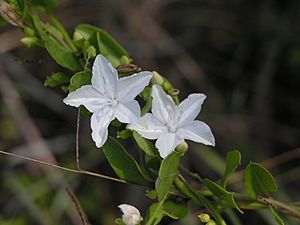Beach clustervine facts for kids
Quick facts for kids Beach clustervine |
|
|---|---|
 |
|
| Conservation status | |
| Scientific classification | |
| Genus: |
Jacquemontia
|
| Species: |
reclinata
|
The Jacquemontia reclinata is a very rare flowering plant. It is also known as the beach clustervine or beach jacquemontia. This plant belongs to the morning glory family. It grows only along the southeastern coast of Florida, mainly near South Florida. Sadly, not much of its natural home is left. This plant is listed as a federally endangered species, meaning it is in danger of disappearing forever.
Contents
What is the Beach Clustervine?
The beach clustervine is a type of creeping vine. It has a strong, woody base. Its stems can grow up to one meter (about 3 feet) long. These stems often climb on other plants.
Plant Features
The vine has thick, fleshy leaves. They can be up to 3 centimeters (about 1 inch) long. It also produces pretty, star-shaped white flowers.
Where it Grows
This plant lives on barrier islands. You can find it in different places there. These include sand dunes and tropical hardwood hammocks. It likes sunny, open areas. It also grows in bare spots. These spots were historically made by strong hurricanes. Today, human activities sometimes create these open patches. Other plants that grow nearby include seagrape and Madagascar periwinkle.
Why is it Endangered?
The beach clustervine is facing many threats. Its population has been shrinking over the years.
Declining Numbers
In 2001, there were only about 733 of these plants known. They were found in ten different groups. By 2007, the total number of plants had dropped by 13% since the year 2000.
Where it is Found
Today, this plant is found in Broward, Palm Beach, and Dade Counties in Florida. It used to grow in Martin County, but it is now thought to be gone from there.
Threats to its Habitat
The coastal areas where this plant lives are very crowded. More and more homes and businesses are being built. This means the plant's natural home is being destroyed. The places where the plant still grows are often broken up into small pieces. They are also damaged.
Invasive Plants
One big problem is introduced plant species. These are plants that are not native to Florida. They grow very fast and take over. An example is Brazilian pepper. It can push out the native beach clustervine.
Human Activities
Other threats include people using the beaches for fun. Also, beach erosion (when the sand washes away) harms the plant. These issues make it harder for the beach clustervine to survive.


